Container Japanese Maples: Tips & Tricks from a Pro
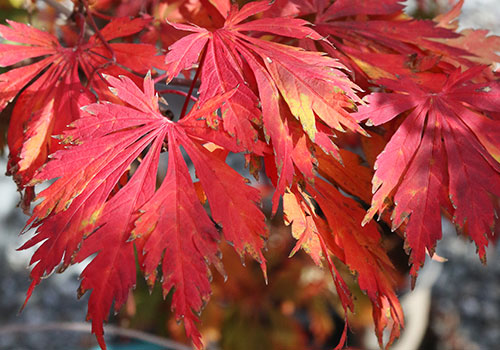
See our favorite maples for Fall 2022!
Planting Japanese maples in containers is a great opportunity to add beauty, height & interest to your view, whether it’s on a back porch patio or part of a larger landscape. And, it’s easy to keep them happy and healthy when you meet their basic needs. Check out the container maple tips below, recommended from the pros at Sky, and if you need extra advice feel free to come in; we’d love to answer any other questions.
Consider the Light
Always match the sun requirements of the location with the type of Japanese maple you are selecting. Most maples that take good sun will also take part sun. However, the part sun or shade maples will not tolerate full sun. Delicate variegated varieties like ‘Ukigumo’ (also known as ‘Floating Clouds’) will take full sun but its white speckled leaf will disappear and be more green. Western sun & rooftop decks can be challenging for maples that prefer more shade. Matching your maple with its desired sunlight will ensure the best color in the leaves and keep your maple vigorous and healthy.
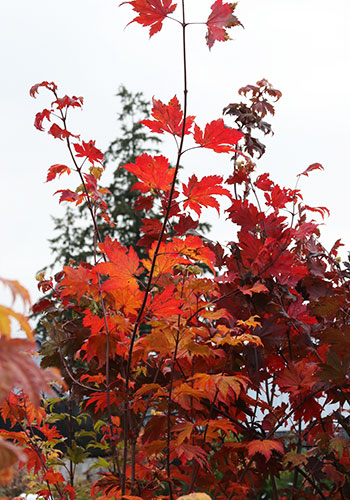
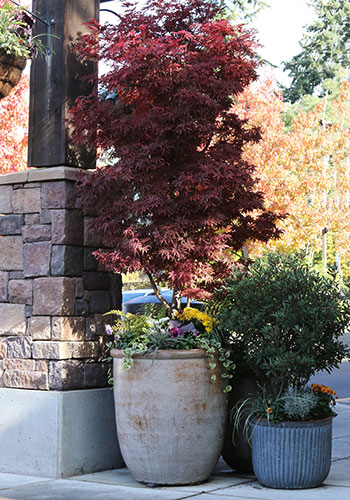
Planting Basics
Choose a container with good drainage holes and a good size for your tree. The ideal soil mix for a maple in a container is one-half EB Stone Azalea Mix blended with one-half Edna's Best Potting Soil. If you can't mix, use straight Edna's. Try not to use any potting soils with added fertilizers or wetting agents, and never use topsoil or soil from your garden bed- it will be too "heavy" for your maple in a pot.
Functional Fertilizer
Fertilize once or twice during the growing season using a slow release organic fertilizer that is formulated for acid-loving plants. EB Stone’s Rhody, Azalea, and Camellia food is a good choice. Organic fertilizer is slow releasing and contains beneficial fungus and bacteria that will help your plant absorb more water and nutrients. Stay away from manures and from water-soluble fertilizers, especially with high nitrogen. Apply your organic fertilizer in mid-March and again around July 4th. Be careful not to fertilize later in the season. Your maple will have difficulty going dormant and may suffer from frost damage.
Watering Your Maple
As with most plants, maples don’t love to be overwatered. Watering the roots deeply once a week will ensure your maple is properly hydrated. In the summer months, a container maple may need to be watered twice a week. Avoid getting water on the leaves, and try not to water in the evening if possible. Morning is the best time to water, so that the plant doesn’t stay damp overnight. In the Pacific Northwest, it's not necessary to water your maple during the rainy season, unless it is under cover.
On Mulch & Soil Cover
Covering the roots of container maples can help them make it through the heat of summer. Chunky bark makes a great mulch, or you can create summer covers from burlap to decrease evaporation. Fit the burlap over the container and trace with a felt pen. Cut with scissors for a perfect fit to sit inside the lip of the container. The moisture in the soil will be more consistent between watering cycles.
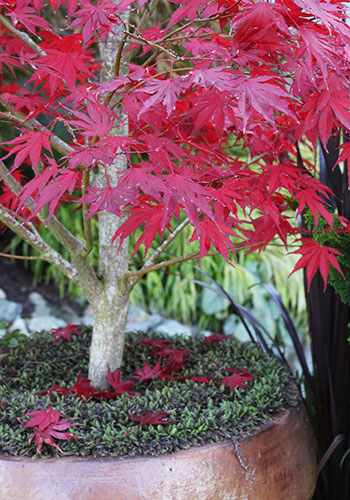
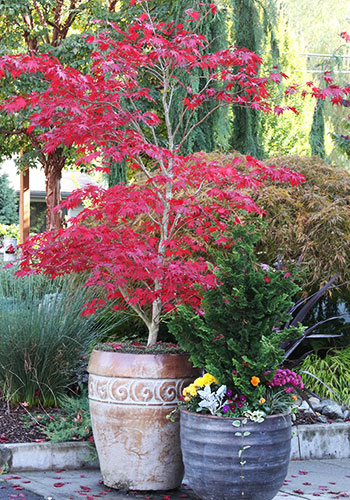
On Companion Planting
It's not recommended to plant other plants in the same container with your Japanese maple. If you choose to do so, the competition of other plants will eventually deplete the potting soil. Digging into the maple root mass to plant additional plants can cause die back. Maples can tolerate this imposition for the first year or two, but eventually the whole container will deteriorate and be in poor health.
Long Term Maintenance
Potting soil in a container may become exhausted after a few years. It may be necessary to reinvigorate the soil with specific mineral additives. Minerals keep your container maple vigorous and enhance leaf color. There are several products out on the market: Iron-tome, Ferti-lome Iron and Dr. Iron are some of them. It's important to follow the directions carefully. If you’re looking for the easiest option, we recommend Ferti-lome Iron.
Plan to Prune
Pruning is an important part of maintaining a container japanese maple. Try not to prune your maples during the rainy season. The damp environment may make some maples more susceptible to bacterial and fungal diseases. June through August is good for pruning aesthetically, since you can see the leaves and the overall shape of the tree. January during a dry spell can also be a good time for pruning and seeing the tree’s core structure. Cut out any dead, diseased, or damaged branches, then prune to shape. To reduce the potential for spreading disease, clean your pruners with alcohol after each cut, especially if cutting dead or diseased branches.
Root prune your container maples when they are so root bound that water doesn't soak through the pot. Another sign that it’s time to root prune is that the top of the tree leaves are crispy and unhealthy looking. Late February is the best time, right before the weather begins to warm up. Be sure to use fresh potting soil during this process.If you have never done root pruning, it's best to consult a nursery professional who can give you some tips and advice.
Whether you already own a container Japanese Maple or you’re looking to start your first, this guide illustrates how truly simple and straightforward the process can be. Take good care, and you’ll have a thriving ‘Baby Ghost’ or ‘Ryusen’ in no time!
Co-written by Sky Employees John B. and Toby M.
